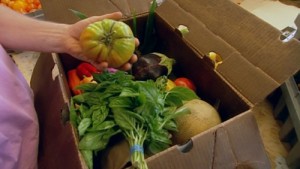URBANA, Ill. — University of Illinois professor of agricultural law A. Bryan Endres and his wife are both lawyers so, between the two of them, they’ve read a lot of legal documents, but when they became members of their local Community Supported Agriculture, even they struggled to understand the agreement they were asked to sign.
Endres’s experience as a consumer led him to develop simple contracts that can clarify expectations, avoid misunderstandings, and protect farmers and their customers.
What they are
CSAs create a partnership between local farmers and consumers who become members or subscribers in support of the farm by purchasing a “share” in the farm. Depending on the agreement, the share may be a box of vegetables, eggs, flowers or other produce delivered to the consumer each week.
“Some CSAs are highly organized, very professional,” Endres said. “In my own CSA, the member agreement we signed had elements of legality, but it was very unclear. Even simple things like how much money we needed to send in and when to send it, weren’t clear in the membership agreement.
“It got me thinking that the membership agreement is a key part of the CSA, and an unclear membership agreement can create a barrier to people joining CSAs. It’s actually a contract between the farmer and the CSA member who wants to get the vegetables every week, so a well-written and clear contract is much better for everyone.”
Formalize expectations
Endres said this year’s drought conditions offer a perfect example of the need for a clear membership agreement.
“If your CSA didn’t have the irrigation, it’s unlikely you received a lot of vegetables and you might be severely disappointed if your expectations aren’t met,” he said.
“The purpose of the membership agreement isn’t to make it more legalistic, but to formalize the expectations of both parties and explain in better detail that as a CSA member you really are sharing the risk of production — including droughts.”
Endres pointed out that the CSA is also not the farmer’s only outlet.
“They may have a certain part of the farm segregated, or a certain percentage set aside for the CSA and another area for the farmers’ market,” Endres said. “The membership agreement provides the farmer with the opportunity to spell out exactly how they divide the bounty of the harvest among their constituents.
“It’s really about setting expectations. Stating farm marketing practices at the beginning eliminates a lot of potential misunderstandings.”
Endres and postdoctorate legal researcher Rachel Armstrong obtained copies of membership agreements from existing CSAs and used them to develop easy-to-understand contracts for CSA owners to use.
“Some CSAs just had a sheet of paper for people to sign their name and their email address,” Endres said. “Others had really nice-looking forms and contracts, but those tended to be the very large CSAs that have hundreds and hundreds of members.
“There’s a range of businesses out there, and we hope our model agreements will provide some sort of baseline that can help CSAs become even more successful.”
The downloadable contracts are available at www.directfarmbusiness.org/csa-introduction/ . Endres said the forms are written in a nontechnical format with a readability level that’s clear to both sides, not like reading a formal lease or, even worse, a cellphone contract.
Webinar
Endres and Armstrong are also offering a free webinar on the potential legal risks of running a CSA and strategies for crafting CSA member and worker agreements. The webinar will be held Dec. 10, at 6 p.m. CST. Instructions on how to attend/register for the webinar are available at www.farmcommons.org or by calling 608-616-5319.
Because about 30 percent to 50 percent of CSAs allow people the option to work on the farm for their share of produce rather than accepting money, Endres and Armstrong have also created a model agreement between farmers and workers on the farm.
“The farmer has created an employer/employee relationship,” Endres said. “What legal implications could that be triggering for the farm owner? Do you need to have workers’ comp? Illinois is very flexible on agricultural labor because we’ve exempted small-scale farms from most of those rules, but other states around the country, such as Wisconsin, have very strict rules for agricultural labor.”
Purpose
Armstrong said that the purpose of a worker agreement is to raise the liability risk awareness not to discourage worker shares so that everyone has a clear picture.
“Some farms already hire employees and already have that structure set up,” she said. “It may be enough to tell your insurance agent what you’re doing and pay a little more each month in insurance to make sure you’re covered.
Armstrong said farmers are concerned the legalities will change the personal relationship feel of the CSA and take the ‘community’ out of Community Supported Agriculture.
“Farmers are trying to build community,” Armstrong said. “There’s a handshake. I trust you. You trust me. They have social motivations for developing CSAs, but they’re not going to be building much community if they get put out of business. The industry can’t grow.
“Most Americans cannot participate in CSAs if we don’t straighten things out and address these legal concerns. It’s about growing the industry and protecting the farmer.”











